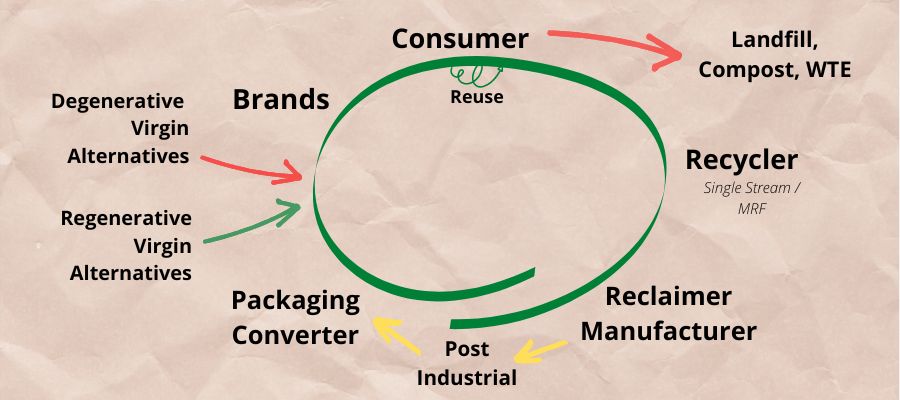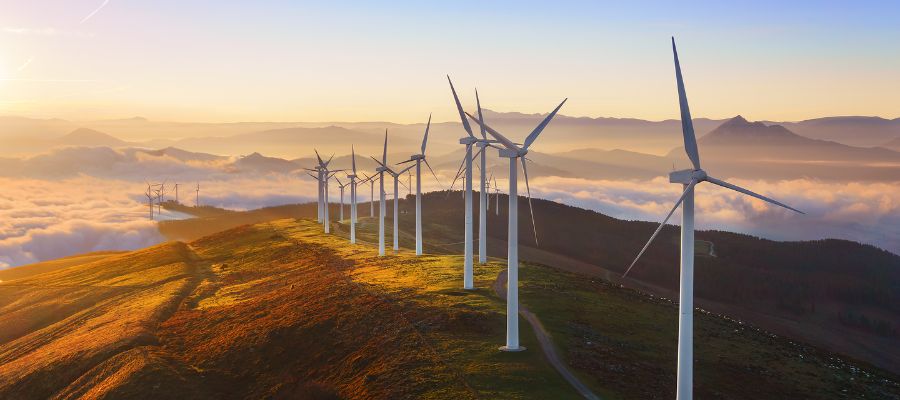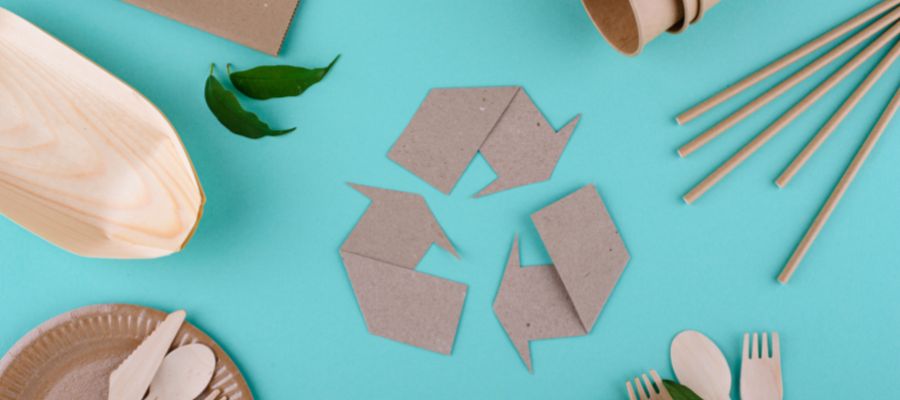There is No Such Thing as Sustainable Packaging (Yet)
Posted on Jan 11th 2023
There is No Such Thing as Sustainable Packaging (Yet)
We describe our packaging as being sustainable and eco-friendly.
In fact, you’ll find these words all over our website.
But even while we use the phrase - sustainable packaging - to describe our offerings, we also fully recognize that we, and the entire packaging industry (and really, businesses across all industries!), are misusing the word.
In 1987, the United Nations Brundtland Commission defined sustainability as “meeting the needs of the present without compromising the ability of future generations to meet their own needs.”
We believe EcoEnclose packaging is the most eco-friendly on the market and has a significantly lower negative impact on the planet than the traditional options it is replacing.
But, we also know that our packaging is still not truly “sustainable.” The manufacturing and transportation of our packaging (even when the packaging is 100% recycled) still creates emissions and utilizes non-renewable resources, and because not all of it ends up getting recycled - some of this packaging is landfill-bound waste.
This means that our packaging - like all packaging today - depletes our planet’s resources and therefore could not be produced and used in perpetuity.
What Would it Look Like for Packaging to Be *Truly* Sustainable and Circular?
We thought you’d never ask!
This reality - that even the most “sustainable packaging” today is still not truly sustainable - has led us to create a vision that drives every product improvement and innovation we pursue.

Specifically, we envision a circular future in which all EcoEnclose packaging (and ideally, all packaging!) is:
- Made from packaging (i.e. recycled content derived from packaging)
- Then turned back into packaging (after being reused as many times as possible)
- Manufactured and shipped with clean, renewable energy sources
- Made with as little material as possible (while still protecting products / contents)
- When virgin inputs are required, made from inputs whose production and extraction actually strengthens soils, waterways, and natural landscapes and habitats
When this vision is achieved, packaging will actually be sustainable - even according to the United Nation’s definition. Its production would not compromise natural resources and, in fact, would actually improve the health of our planet for future generations.
We know we are far from this vision today!
Today, the majority of our packaging is made from recycled content (though occasionally, we still have to incorporate virgin inputs). We have to rely on fossil fuels for our manufacturing and transportation. It is likely that some end consumers who receive our packaging landfill these items, meaning that they don’t have a chance to become packaging in their next life.
But each month we make forward progress towards our ultimate goal. Examples include:
- Moving from a 32.6% recycled bubble mailer to a 50% recycled bubble mailer (with some post-consumer waste)
- Introducing our poly film take back plan, which has increased the amount of bubble mailers, clear poly bags and poly mailers that get recycled
- Introducing next generation fibers into pilot product lines, to help spur the production of virgin paper derived from waste rather than trees
Read more about our innovations here!
So, Why Do We Use The Term Sustainable to Describe Our Packaging?
For better or worse, brands across all industries - as well as non-profits, policy makers and industry associations - generally use the word “sustainable” to describe options that are more eco-friendly than standard options.
For example, “sustainable fashion” is typically used to describe apparel brands with a commitment to ethical supply chains, eco-friendlier materials, and high quality (in direct opposition to fast fashion).
Sustainable energy encompasses everything from wind to solar to biofuel energy.

These alternatives to fast fashion and petroleum are not yet at a point where they have no negative impact on the planet. They are, however, significantly better for the planet and human dignity than the standards they are replacing.
Similarly, EcoEnclose packaging is much more environmentally friendly than standard packaging (the kind made from virgin materials, made overseas in factories with unknown working conditions, and / or are unrecyclable).
We therefore use the word sustainable because we know that this is the language the brand we work with use, and how their consumers describe better alternatives. We also use descriptors like earth-friendly, eco-friendly or eco-friendlier, and eco-conscious.
How Can We Make Sure “Sustainable” Doesn’t Become Greenwashing? When Should The Word Be Used and When Is it Misleading?
In some ways, this is the most important question for consumers, brands and companies like ours to ask.
Across the industry, we often see the term “sustainable packaging” used loosely.

For example, Amazon’s Frustration-Free Packaging Program considers packaging to be sustainable if it is curbside recyclable, even if that packaging is made from virgin paper that is derived from primary forests. Some packaging providers promote compostable PLA packaging as being sustainable, despite the havoc that this type of packaging is having on soil, ocean health and compost facilities. Some brands are describing their packaging as being sustainable if they have been able to “lightweight” it by a significant amount (i.e. reduce its weight by a 30%), even if that material is still made with virgin content and/or is unrecyclable)
Should these these three examples be considered “sustainable”?
At EcoEnclose, these specific three types of packaging would not be described as sustainable or even eco-friendly, despite the fact that some are examples of packaging that is certainly better than whatever it was replacing.
At EcoEnclose, we have made the decision to use the descriptor “sustainable” for our packaging if it actually meets our Sustainable Packaging Framework:
- It has the most recycled content possible (and is industry leading when it comes to recycled content and post-consumer waste levels)
- It can be recycled at the end of its useful life (and, where appropriate, can be reused first)
- We have been thoughtful about minimizing the volume of material needed, are manufacturing relatively close to where the packaging will be shipped, and are able to have transparency into the ethics and accuracy of information across the supply chain
In some situations, such as with our standup pouches, our glassine bags and our honeycomb GreenWrap, we offer packaging solutions that are either unrecyclable or made with virgin material. In these instances, we aim to be very transparent about the shortcomings of our packaging, while explaining why we still see them as being ecologically best-in-class compared to the packaging solutions they are replacing.
Perhaps most importantly, we attempt to follow vague terms like “eco-friendly” and “sustainable” with as much specific information as possible about why we’ve labeled the packaging this way, with phrases such as:
- X% recycled content, with Y% post-consumer waste
- Manufactured in the USA, with recycled content coming from domestic markets
- Made with X% wheat straw agricultural waste and Y% post-consumer waste
- Curbside recyclable in most municipalities
- Thin film recyclable
Our hope is that by sharing this level of detail, our brands can also evaluate for themselves if the solutions we are offering meet their framework and definitions of sustainable packaging (in a world in which no packaging is truly sustainable according to the United Nation’s accepted definition!). Check out our glossary of terms to learn more about the words we use when describing our products' eco-features, and what they actually mean.
Why Does This Nuance Even Matter and How Should It Guide the Actions of EcoEnclose and Our Brands?
We wrestle with these nuances all the time internally, debating questions like - “is it even appropriate to use the word sustainable given the fact that consumption is still net negative?” or “would we consider a 70% recycled mailer to be sustainable or eco-friendly, knowing a 100% recycled alternative is achievable?”
While these conversations can lead to frustrating rabbit holes, and probably hinder our ability to be as focused and compelling in our marketing and messaging, I think they do ultimately make us better in terms of how we can serve you - our EcoAllies - in navigating the complicated question of, “what is the best packaging solution for my business and the planet?”
Given how we’ve benefited from these internal debates, I think all eco-conscious brands (and consumers!) would benefit from recognizing the inherent inaccuracies of how we all use the word sustainable. Specifically, I encourage people to:
- Acknowledge, internally, that decisions you’re making across your business may be described as “sustainable” without actually meeting the technical United Nations definition of the word (not punishing yourself for this, but simply at least acknowledging it).
- Create your own sustainability vision: What would the future look like if my product and company were *truly* sustainable - for the planet and people?
- Establish an internal threshold for what “counts” as being an eco win, that you would be comfortable describing as being sustainable, eco-friendly, or earth conscious. This may be as specific as, “Apparel that uses X% less water, generates Y% less carbon emissions, and sheds no microplastics will be considered sustainable within my brand.” Or it can be a bit broader, i.e. “Any product that is made with all recycled content and is designed for long-term durability will be considered eco-friendly.” Make your thresholds and definitions clear internally and to your customers. And consider revising them annually. You’ll find that you are constantly upping your game, and eco-wins that are hard this year steadily become more commonplace, allowing you to stretch your threshold closer and closer to your long-term sustainability vision.
- Be specific, clear and thoughtful when you use sustainability terms with your customers. Words like natural, sustainable, non-toxic, eco-friendly, green are vague and are a missed opportunity to create a more informed and picky consumer base. This level of specificity is also very helpful in ensuring your messages are not unintentionally greenwashing. Check out our library of assets and recommended phrases to use when designing your packaging to showcase your eco-commitment.


